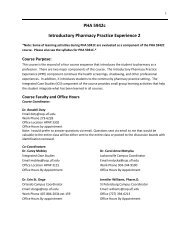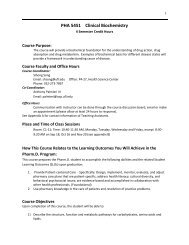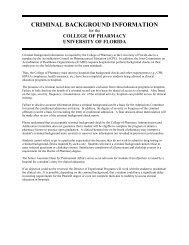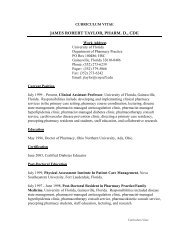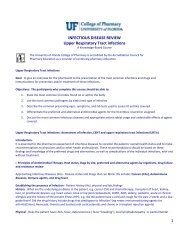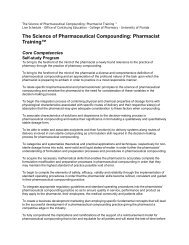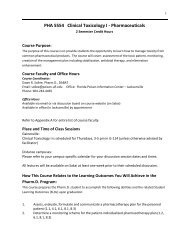Module 3: The Drug Regimen Review - College of Pharmacy ...
Module 3: The Drug Regimen Review - College of Pharmacy ...
Module 3: The Drug Regimen Review - College of Pharmacy ...
Create successful ePaper yourself
Turn your PDF publications into a flip-book with our unique Google optimized e-Paper software.
gabapentin<br />
lamotrigine<br />
levetiracetam<br />
oxcarbazepine<br />
phenobarbital<br />
phenytoin<br />
primidone<br />
valproic acid<br />
schizoaffective disorder, chronic neuropathic pain,<br />
and for prophylaxis <strong>of</strong> migraine headaches<br />
• Need for indefinite continuation should be based on<br />
confirmation <strong>of</strong> the condition (for example,<br />
distinguish epilepsy from isolated seizure due to<br />
medical cause or distinguish migraine from other<br />
causes <strong>of</strong> headaches) and its potential causes<br />
(medications, electrolyte imbalance, hypocalcemia,<br />
etc.)<br />
Duration<br />
• If used to manage behavior, stabilize mood, or treat a psychiatric<br />
disorder, refer to Section V - Tapering <strong>of</strong> a Medication Dose/Gradual<br />
Dose<br />
Reduction (GDR) in the guidance<br />
Monitoring<br />
• Serum medication concentration monitoring is not<br />
required or available for all anticonvulsants. Only<br />
the following anticonvulsants should be monitored<br />
with periodic serum concentrations: phenytoin,<br />
phenobarbital, primidone, divalproex sodium (as<br />
valproic acid), and carbamazepine<br />
• Serum medication concentrations may help identify toxicity, but<br />
significant signs and symptoms <strong>of</strong> toxicity can occur even at normal or<br />
low serum concentrations.<br />
• When anticonvulsants are used for conditions<br />
other than seizure disorders (e.g., as mood<br />
stabilizers), the same concerns exist regarding<br />
the need for monitoring for effectiveness and<br />
side effects; but evaluation <strong>of</strong> symptoms - not<br />
serum concentrations - should be used to<br />
adjust doses.<br />
o High or toxic serum concentrations<br />
should, however, be evaluated and<br />
considered for dosage adjustments<br />
o Symptom control for seizures or<br />
behavior can occur with<br />
subtherapeutic serum medication<br />
concentrations<br />
Adverse Consequences <br />
May cause liver dysfunction, blood dyscrasias, and serious skin rashes<br />
requiring discontinuation <strong>of</strong> treatment<br />
May cause nausea/vomiting, dizziness, ataxia,<br />
somnolence/lethargy, incoordination, blurred or<br />
double vision, restlessness, toxic encephalopathy,<br />
anorexia, headaches. <strong>The</strong>se effects can increase the<br />
risk for falls



